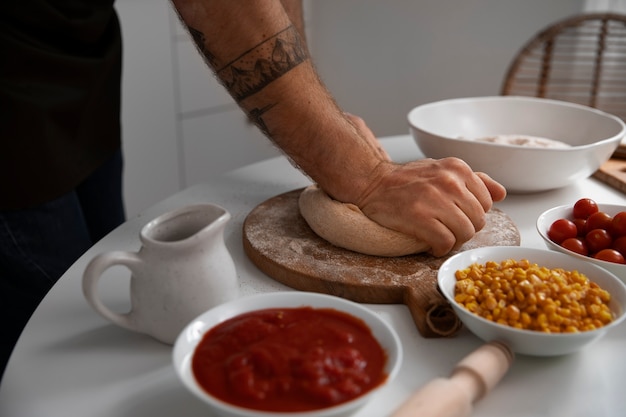Let’s be honest, there’s something truly satisfying about the aroma of italian sausage sizzling in a pan, isn’t there? It’s a taste of comfort, a reminder of family gatherings, and a flavour that can transport you to sun-drenched Italian streets. But cooking italian sausage isn’t just about throwing it in a pan and calling it a day. It’s about understanding its nuances, mastering its preparation, and unlocking its full potential. That’s where this guide comes in – your journey from sausage novice to culinary connoisseur.
(Part 1) The Basics: Understanding Your Sausage

Before you even think about flipping that sausage in a pan, it's crucial to understand what you're working with. Italian sausage isn't just one thing, you know. It’s a world of flavours, textures, and spices waiting to be explored.
types of italian sausage: Sweet, Spicy, and Everything In Between
There are two main categories you need to know:
- sweet italian sausage: This is your go-to, your trusty companion. It’s got a mild flavour, just a hint of spice, making it perfect for everything from pasta dishes to pizzas. It’s the kind of sausage you can always rely on, your culinary comfort blanket.
- hot italian sausage: This sausage packs a punch, let me tell you! It’s got a serious kick, thanks to the addition of red pepper flakes or hot peppers. Now, if you're looking for a bit of a thrill, this is your sausage. Just be prepared for a tastebud adventure, maybe grab a glass of milk for good measure!
And then, there’s the matter of casing. You can get Italian sausage in natural casing, which is made from the intestines of the animal, or in artificial casing, which is basically a plastic tube. I prefer natural casing because it gives the sausage a bit more flavour and that satisfying snap when you bite into it. It’s like a little culinary surprise.
Choosing the Right Sausage: A Beginner's Guide
Right, now that you know the types, let's talk about choosing the right one for your needs. If you're a beginner, I'd recommend starting with sweet Italian sausage. It's less intimidating, and it’s a great base for experimenting with different flavours. If you’re feeling adventurous, go for hot Italian sausage, just make sure you've got some milk or a cool drink on hand for when the heat hits you!
And remember, when choosing your sausage, always check the label. You want to make sure you're getting good quality sausage, made with fresh ingredients. Look for sausages that are minimally processed and avoid those with added fillers or artificial ingredients. You'll also find a lot of sausages that are pre-seasoned, which is great for convenience, but if you want to control the flavour, look for plain sausage and season it yourself. This way, you can tailor the spice levels and flavour profile to your own taste.
(Part 2) Cooking Italian Sausage: Mastering the Basics

Alright, you’ve got your sausage, you’ve got your plan, now let’s get cooking! There are a few basic ways to cook Italian sausage, each with its own advantages.
Pan-Frying: The Classic and Quick Method
This is the simplest and most popular method, hands down. It’s quick, easy, and you can do it on the stovetop or in a skillet. Here's how to nail it:
- Heat some olive oil in a large pan over medium heat. Don't skimp on the oil, you want your sausages to brown nicely.
- Carefully add the sausage to the pan, making sure not to overcrowd it. You want to cook the sausage evenly, so give each one some space to breathe.
- Cook for about 8-10 minutes, turning every couple of minutes, until the sausage is cooked through and browned on all sides. You'll know it's done when it reaches an internal temperature of 160 degrees Fahrenheit. Use a meat thermometer to be sure.
- Once cooked, remove the sausage from the pan and drain any excess fat. This will help prevent your dish from being too greasy.
And there you have it, simple, right? But remember, you can take your pan-fried sausage to the next level by adding some extra flavour. Try deglazing the pan with a bit of white wine or chicken broth, or add some onions, peppers, or garlic for a delicious and aromatic meal.
Grilling: For Those Summer BBQs
There’s nothing quite like the smoky flavour of grilled Italian sausage, is there? It’s perfect for those summer BBQs, picnics, and outdoor gatherings. Just make sure you preheat your grill to medium-high heat and cook the sausage for about 8-10 minutes, turning every few minutes, until it's cooked through and has those beautiful grill marks. Don't forget to brush the sausage with some olive oil or bbq sauce before grilling to add extra flavour.
Baking: A Mess-Free Option
Looking for a less messy way to cook your sausage? Baking is your answer! It's a great option for a crowd, because you can bake a whole bunch of sausages at once. Just preheat your oven to 375 degrees Fahrenheit, arrange the sausages on a baking sheet, and bake for about 20-25 minutes, turning them halfway through, until they're cooked through. If you want to add some flavour, try drizzling them with olive oil and seasoning them with herbs and spices.
slow cooking: For Tender and flavorful sausage
Ah, the slow cooker, a kitchen wizard! It’s perfect for making sausage that's tender and full of flavour. Just throw the sausage in the slow cooker with some onions, peppers, and your favourite seasonings, and cook on low for 6-8 hours or on high for 3-4 hours. The slow cooker does all the work, and you get a delicious, melt-in-your-mouth sausage.
(Part 3) Beyond the Basics: Exploring sausage dishes

Now, we’ve covered the basics of cooking Italian sausage, but the real fun begins when you start exploring the endless possibilities! Here are some of my favourite ways to use Italian sausage.
Classic Italian Sausage with Peppers and Onions: A Timeless Delight
Let’s be honest, sometimes the simplest things are the best. This dish is a classic for a reason. Just sauté some onions and peppers with Italian sausage until they're tender and caramelized. Serve it with a side of mashed potatoes, polenta, or crusty bread. It's comfort food at its finest, and it's so easy to make. You can even add a sprinkle of fresh parsley or a drizzle of balsamic vinegar for an extra touch of flavour.
Italian Sausage Pasta: A Hearty and Satisfying Meal
Pasta with Italian sausage? A match made in heaven, I tell you! There are so many variations, but my favourite is a simple tomato sauce with Italian sausage, onions, garlic, and a splash of red wine. It’s a hearty and satisfying dish that’s perfect for a cold night. You can also add some fresh herbs, like basil or oregano, to enhance the flavour profile.
Italian Sausage Pizza: A Flavour Bomb
No pizza night is complete without a good dose of Italian sausage, right? Whether you’re making a homemade pizza or ordering takeout, Italian sausage is a delicious and versatile topping. I love adding it to a classic Margherita pizza, or pairing it with roasted red peppers, mushrooms, and mozzarella cheese. It’s a flavour bomb, and it's always a crowd-pleaser.
Italian Sausage Soup: A Warm and Comforting Winter Treat
Looking for something warm and comforting? Try making an Italian sausage soup! It’s a perfect winter warmer, full of flavour and packed with nutrients. Simply brown some Italian sausage, add some vegetables like onions, carrots, and celery, and simmer everything in a rich broth. Add some pasta, rice, or polenta for a hearty meal. You can also add a touch of acidity with a squeeze of lemon juice for a more complex flavour.
Italian Sausage stuffed peppers: A Show-Stopping Dish
For a delicious and impressive dish, try stuffing peppers with Italian sausage, rice, and cheese. It’s a great way to use up leftover sausage, and it’s a fantastic dish for a potluck or a dinner party. You can use bell peppers, poblano peppers, or even Anaheim peppers for a variety of flavour profiles.
Italian Sausage Breakfast Sandwiches: A Hearty Way to Start Your Day
Don’t limit your sausage to just dinner! Italian sausage is also fantastic for breakfast. Make a breakfast sandwich with a fried egg, cheese, and your favourite Italian sausage, served on a toasted english muffin or bagel. It's a hearty and satisfying way to start your day. You can also add some caramelized onions or sautéed mushrooms for extra flavour.
(Part 4) Getting Creative with Italian Sausage: Unleash Your Inner Chef
So, you’ve got the basics down, and you’ve tried a few classic dishes. Now, it’s time to get creative. Italian sausage is a blank canvas, waiting for your inspiration. Here are a few ideas to get your creative juices flowing.
Experiment with Flavours: A World of Spice and Herb
Don't be afraid to experiment with different herbs and spices! Try adding some rosemary, thyme, sage, or oregano to your sausage for a fragrant flavour boost. For a spicier kick, add some red pepper flakes or a pinch of cayenne pepper. You can also use a mix of spices, like a combination of paprika, cumin, and coriander. The possibilities are endless, just let your taste buds guide you.
Add Some Colour: A Culinary Palette
Italian sausage isn’t just about flavour, it’s about colour too. Add some colourful vegetables, like bell peppers, onions, zucchini, or mushrooms, to your sausage dishes. Not only will they add a beautiful pop of colour, they’ll also bring a variety of textures and flavours to the table.
Think Outside the Box: Unconventional Sausage Delights
Don’t be afraid to think outside the box when it comes to Italian sausage. Try using it in unexpected ways, like adding it to salads, stir-fries, or even tacos! The possibilities are endless!
(Part 5) Tips and Tricks: Making Your Sausage Journey a Success
Alright, so you’re ready to get cooking, but before you start, here are a few tips and tricks to make sure your Italian sausage journey is a success.
Don’t Overcrowd the Pan: Space for Sausage
If you overcrowd the pan, the sausage won’t cook evenly, and you’ll end up with a greasy mess. Make sure you leave some space between the sausages so they can cook properly.
Cook to the Right Temperature: food safety First
It’s crucial to cook the sausage to an internal temperature of 160 degrees Fahrenheit to ensure it’s safe to eat. Use a meat thermometer to check the temperature, and don’t worry about overcooking it, as it won’t affect the flavour.
Don’t Be Afraid to Drain the Fat: A Less Greasy Meal
Italian sausage can be quite fatty. Draining the excess fat will prevent your dish from being too greasy. Use a slotted spoon to remove the sausage from the pan and drain it on paper towels.
Use the Sausage Fat: A Flavorful Boost
Don’t throw away all that fat! You can use it to add flavour to other dishes, like sautéed vegetables or soups. Just let it cool down, then remove any solid bits and store it in the refrigerator.
Seasoning: Creating Your Signature Sausage
If you’re using unseasoned Italian sausage, don’t forget to season it before cooking. A simple blend of salt, pepper, garlic powder, and onion powder will do the trick. You can also add other herbs and spices to your liking.
Storage: Keeping Your Sausage Fresh
Italian sausage can be stored in the refrigerator for up to 3-4 days. Just make sure you keep it in its original packaging or wrap it tightly in plastic wrap. You can also freeze Italian sausage for up to 3-4 months. Just wrap it tightly in plastic wrap and aluminum foil.
(Part 6) Italian Sausage Around the World: A culinary journey
Alright, we’ve covered the basics, we’ve talked about dishes, but let’s take a trip around the world, shall we? Italian sausage isn’t just a British thing, you know. It’s got a global presence. Let’s see how different cultures use this beloved ingredient.
Italy: The Birthplace of Sausage
Of course, we have to start with Italy, the birthplace of Italian sausage! In Italy, sausage is called "salsiccia" and it's a staple in many regional cuisines. You'll find it used in pasta dishes, soups, and stews, and it's often served with vegetables like peppers, onions, and mushrooms. It’s a versatile ingredient that reflects the rich culinary heritage of Italy.
United States: A Sausage Revolution
Italian sausage has been embraced in the United States, and it’s become a real favourite. You’ll find it on everything from pizzas and sandwiches to tacos and breakfast burritos. It’s a versatile and delicious ingredient, and it’s a key part of American cuisine. The American love affair with Italian sausage is a testament to its adaptability and flavour.
Argentina: A Spicy Twist
In Argentina, Italian sausage is called "chorizo" and it’s typically made with a blend of pork, beef, and spices. It’s often seasoned with paprika, cumin, and garlic, and it has a distinctive spicy flavour. You’ll find it served in sandwiches, empanadas, and even as a topping for grilled meats. It’s a testament to the influence of Italian cuisine on Latin American food culture.
Germany: A Wurst Celebration
Germany is known for its love of sausages, and Italian sausage is no exception. It’s often called "italienische Wurst" and it’s a popular ingredient in dishes like pasta salads and hot dogs. You’ll also find it used in traditional German dishes like "Sauerbraten" (a marinated pot roast) and "Schnitzel" (a breaded and pan-fried cutlet). It’s a reminder that Italian sausage can seamlessly blend into diverse culinary traditions.
(Part 7) Serving Up Your Sausage Delights: A Culinary Presentation
So, you’ve cooked your Italian sausage, you’ve experimented with flavours, and now it’s time to serve it up. Make it an occasion!
Presentation is Key: A Feast for the Eyes
Don’t just throw your sausage on a plate, make it look tempting! A little bit of effort goes a long way. Use colourful serving platters, and arrange your sausage attractively.
Sides and Sauces: Complementary Flavours
Don’t forget about the sides! Italian sausage goes well with a variety of sides, like mashed potatoes, polenta, pasta, salad, or crusty bread. And don’t be afraid to add a bit of sauce to your dish, whether it’s a simple tomato sauce or a more complex pesto sauce.
Don’t Forget the Drinks: A Toast to Good Food
What’s a meal without a good drink? A crisp white wine or a light red wine goes well with Italian sausage. You can also serve it with a refreshing beer or a cold glass of water.
Enjoy! Savor the Flavour
Most importantly, relax and enjoy your Italian sausage! It’s a delicious and versatile ingredient that can be enjoyed in a variety of ways. So, go on, get creative, and have fun with it!
(Part 8) FAQs: Your Italian Sausage Questions Answered
What are the best herbs and spices to use with Italian sausage?
The classic combination for Italian sausage is a blend of garlic powder, onion powder, oregano, basil, and red pepper flakes. But you can experiment with other herbs like rosemary, thyme, or sage. For a spicier kick, add more red pepper flakes or some cayenne pepper. It’s all about finding the flavour profile that suits your taste buds.
Can I use Italian sausage in a vegetarian dish?
Yes, you can use vegetarian italian sausage as a substitute for traditional Italian sausage in many recipes. There are several brands that offer vegetarian Italian sausage made from soy protein, wheat gluten, or other plant-based ingredients. It’s a great option for those looking for a meat-free alternative that still delivers the flavour of Italian sausage.
What is the best way to cook Italian sausage for a crowd?
The best way to cook Italian sausage for a crowd is in the oven. Preheat your oven to 375 degrees Fahrenheit, arrange the sausages on a baking sheet, and bake for about 20-25 minutes, turning them halfway through, until they're cooked through. It’s a hands-off method that ensures even cooking and makes it easy to cook for a larger group.
Can I cook Italian sausage on the stovetop without a pan?
It’s not recommended to cook Italian sausage directly on the stovetop without a pan. The sausage will likely stick to the surface, and it’s not safe to cook food directly on a hot stovetop. A pan provides a safe and controlled cooking environment, allowing for even cooking and preventing sticking.
What are some good pairings for Italian sausage?
Italian sausage pairs well with a variety of sides and sauces. Some popular pairings include mashed potatoes, polenta, pasta, salad, crusty bread, tomato sauce, pesto sauce, and white or red wine. It’s a versatile ingredient that complements a wide range of flavours.
Everyone is watching

Prime Rib Roast Cooking Time Chart: Per Pound Guide
Cooking TipsPrime rib roast. Just the name conjures images of lavish dinners, crackling fires, and hearty laughter. It’s ...

How Long to Bake Potatoes in the Oven (Perfect Every Time)
Cooking TipsBaked potatoes are a staple in my kitchen. They're incredibly versatile, delicious, and surprisingly easy to m...

Perfect Rice Every Time: The Ultimate Guide to Cooking Rice
Cooking TipsAs a self-proclaimed foodie, I've always been a bit obsessed with rice. It's the foundation of countless cuisi...

The Ultimate Guide to Cooking Asparagus: Tips, Techniques, and Recipes
Cooking TipsAsparagus. The mere mention of this spring delicacy conjures up images of vibrant green spears, crisp and burs...

Ultimate Guide to Cooking the Perfect Thanksgiving Turkey
Cooking TipsThanksgiving. Just the word conjures up images of overflowing tables laden with delicious food, the scent of r...
